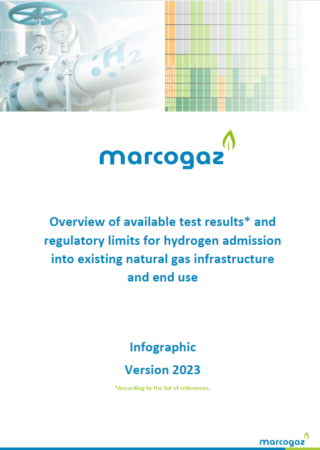MARCOGAZ H2 Infographic 2023 Version
03 October 2023
In October 2019, MARCOGAZ released its initial infographic (see H2 Infographic 2019 version here) to offer an overview of how well gas infrastructure and end-use equipment could handle hydrogen-natural gas (H2-NG) mixtures in different stages of the gas midstream and downstream value chain. This was prompted by the unique properties of H2-NG mixtures, which differ from pure hydrogen (H2) or natural gas (NG), raising questions about the suitability of existing infrastructure.
Since then, the gas industry and academia have shown increased interest in H2-NG mixtures (up to 30% H2), leading to more research and attention. In response, MARCOGAZ has continuously monitored H2 developments and updated the infographic to reflect the current state of knowledge regarding natural gas transmission and distribution systems, including underground storage, gas pressure regulation and metering, and end-use equipment. This update incorporates insights from industry operators and experts.
It’s important to note that the level of knowledge and available information on H2 tolerance may vary across different infrastructure sectors. Occasionally, this leads to variations in the listed H2 tolerances for assets in various parts of the gas infrastructure. The infographic tries to account for these variations as best as possible.
The key objectives of the infographic are as follows:
- Offer an overview of the technical readiness of gas infrastructure and end-use equipment to handle H2-NG mixtures at different stages of the value chain. Currently, the focus is on material properties and functional principles, without considering the impact of increasing H2 levels on performance, efficiency, and output.
- Identify knowledge gaps and areas where research and development (R&D) are needed to overcome barriers hindering H2 adoption in the supply chain and enabling new H2 and H2-NG mixture applications.
- Collect and evaluate the most recent knowledge on H2 and H2-NG mixtures, drawing on evidence and experience from gas network operators, storage operators, and end-use experts.
- Gather and assess the current state of knowledge regarding the transmission, storage, distribution, and end-use of H2-NG mixtures and H2, leveraging the expertise and experience of network operators, storage operators, and end-use experts.
- Support investigations into how existing gas infrastructure can best contribute to achieving climate goals and provide benefits in line with environmental objectives.


